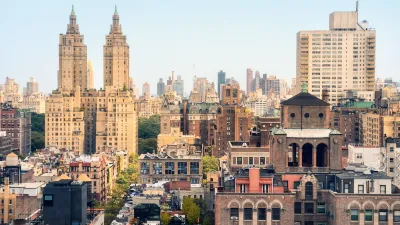A drop in demand for retail space began well before the seismic shifts of the pandemic.

In an article for Slate, Leah Brooks and Rachel Meltzer describe how the retail vacancy crisis began well before the COVID pandemic that accelerated it.
According to the authors, “Since 2012, almost a decade before we can attribute any decline to COVID, the amount of newly leased retail square feet flatlined and even declined in some cities. Also since 2012, retail rents have flattened or declined, and retail spaces sit empty longer between tenants.”
The article asserts that most cities’ zoning codes call for too much retail, leading to inevitable vacancies. This is in part “Perhaps because zoning for ground-floor retail is practically an act of faith among urban planners,” who operate on the belief that mixed-use zoning with ground-floor retail leads to vibrant, walkable neighborhoods. “However, the benefits from this type of planning are nullified when those storefronts sit vacant. Streetscapes pockmarked with dark windows and sidewalks with less foot traffic and fewer eyes can invite illicit and unsafe activity and may even suppress demand for living near those corridors.”
As online shopping and remote work continue to grow, there is no foreseeable resurgence in brick-and-mortar retail, the authors argue. Planners should focus on concentrating retail near transit hubs and mixed-use developments while allowing for residential conversions of spaces where it makes sense.
FULL STORY: Cities Planned Their Way Into the Retail Vacancy Crisis

Planetizen Federal Action Tracker
A weekly monitor of how Trump’s orders and actions are impacting planners and planning in America.

Congressman Proposes Bill to Rename DC Metro “Trump Train”
The Make Autorail Great Again Act would withhold federal funding to the system until the Washington Metropolitan Area Transit Authority (WMATA), rebrands as the Washington Metropolitan Authority for Greater Access (WMAGA).

The Simple Legislative Tool Transforming Vacant Downtowns
In California, Michigan and Georgia, an easy win is bringing dollars — and delight — back to city centers.

The States Losing Rural Delivery Rooms at an Alarming Pace
In some states, as few as 9% of rural hospitals still deliver babies. As a result, rising pre-term births, no adequate pre-term care and harrowing close calls are a growing reality.

The Small South Asian Republic Going all in on EVs
Thanks to one simple policy change less than five years ago, 65% of new cars in this Himalayan country are now electric.

DC Backpedals on Bike Lane Protection, Swaps Barriers for Paint
Citing aesthetic concerns, the city is removing the concrete barriers and flexposts that once separated Arizona Avenue cyclists from motor vehicles.
Urban Design for Planners 1: Software Tools
This six-course series explores essential urban design concepts using open source software and equips planners with the tools they need to participate fully in the urban design process.
Planning for Universal Design
Learn the tools for implementing Universal Design in planning regulations.
Smith Gee Studio
City of Charlotte
City of Camden Redevelopment Agency
City of Astoria
Transportation Research & Education Center (TREC) at Portland State University
US High Speed Rail Association
City of Camden Redevelopment Agency
Municipality of Princeton (NJ)





























